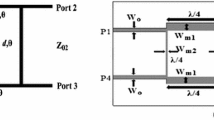Abstract
In this work, a novel branch-line coupler is presented using a new type of microstrip cells. The proposed structure is consisting of high and low impedance sections and a main small square closed loops. It operates at 2.4 GHz for WLAN applications. Using the introduced structure, a good passband performance is achieved. An excellent phase balance closed to ideal is obtained with a phase difference of 270 ± 0.037° between output ports. Furthermore, there are low return loss and high isolation better than − 29 and − 30 dB respectively. Meanwhile, the designed coupler has a good insertion loss and coupling factor. Despite of having a high performance, this coupler is relatively compact with an overall size of 0.037 λg2. The designing method is based on proposing an LC model of a basic microstrip cell and finding the effective parameters to obtain a high performance. In order to validate the designing method and simulation results, the presented coupler is fabricated and measured. There is a good agreement between the simulated and measured results.






Similar content being viewed by others
References
Deng, P.-H., Huang, B.-L., & Chen, B.-L. (2015). Designs of microstrip four-and five-channel multiplexers using branch-line-shaped matching circuits. IEEE Transactions on Components, Packing and Manufacturing Technology, 5(9), 1331–1338.
Noori, L., & Rezaei, A. (2018). Design of a compact narrowband quad-channel diplexer for multi-channel long-range RF communication systems. Analog Integrated Circuits and Signal Processing, 94(1), 1–8.
Noori, L., & Rezaei, A. (2017). Tunable microstrip dual-band bandpass filter for WLAN applications. Turkish Journal of Electrical Engineering & Computer Science, 25, 1388–1393.
Kumar, K., & Karthikeyan, S. (2015). Wideband three section branch line coupler using triple open complementary split ring resonator and open stubs. International Journal of Electronics and Communications, AEÜE, 69(10), 1412–1416.
Wang, Y., Ma, K., & Mou, S. (2016). A compact branch line coupler using substrate integrated suspended line technology. IEEE Microwave and Wireless Components Letters, 26(2), 95–97.
Salehi, M.-R., & Noori, L. (2014). Novel 2.4 GHz branch-line coupler using microstrip cells. Microwave and Optical Technology Letters, 56(9), 2110–2113.
Sa’ad, B., Rahim, S., Peter, T., Rani, M., Ausordin, S., Zaidel, D., et al. (2014). Transparent branch-line coupler using micro-metal mesh conductive film. IEEE Microwave and Wireless Components Letters, 24(12), 857–859.
Jung, Y. (2014). Wideband branch line coupler using symmetrical four-strip interdigitated coupler. Electronics Letters, 50(6), 452–454.
Sa’ad, B., Rahim, S., & Dewan, R. (2013). Compact wide-band branch-line coupler with meander line, cross, and two-step stubs. Microwave and Optical Technology Letters, 55(8), 1810–1815.
Zong, B., Wang, G., Zhang, C., & Wang, Y. (2014). Miniaturised branch-line coupler with ultra-wide high suppression stopband. Electronics Letters, 50(19), 1365–1367.
Kumar, K., Barik, R., & Karthikeyan, S. (2016). A novel two section branch line coupler employing different transmission line techniques. International Journal of Electronics and Communications, AEÜE, 70, 738–742.
Tsai, K., Yang, H., Chen, J., & Chen, Y. (2015). A miniaturized 3 dB branch-line hybrid coupler with harmonics suppression. IEEE Microwave and Wireless Components Letters, 21(10), 537–539.
Dwari, S., & Sanyal, S. (2006). Size reduction and harmonic suppression of microstrip branch-line coupler using defected ground structure. Microwave and Optical Technology Letters, 48(10), 1966–1969.
Salehi, M.-R., Noori, L., & Abiri, E. (2015). Novel tunable branch-line coupler for WLAN applications. Microwave & Optical Technology Letters, 57(5), 1081–1084.
Rezaei, A., & Noori, L. (2018). Microstrip hybrid coupler with a wide stop-band using symmetric structure for wireless applications. Journal of Microwaves, Optoelectronics and Electromagnetic Applications, 17(1), 23–31.
Chen, J.-H., Yuan, S.-Y., Liou, S.-R., & Liao, S.-S. (2017). Compact planar microstrip branch-line coupler using equal difference structure. Microwave and Optical Technology Letters, 59(3), 664–668.
Tan, B.-K., & Yassin, G. (2017). Planar microstrip coupler with enhanced power coupling. Electronics Letters, 53(1), 34–36.
Author information
Authors and Affiliations
Corresponding author
Rights and permissions
About this article
Cite this article
Rezaei, A., Noori, L. & Hosseini, S.M. Novel microstrip branch-line coupler with low phase shift for WLANs. Analog Integr Circ Sig Process 98, 377–383 (2019). https://doi.org/10.1007/s10470-018-1255-9
Received:
Accepted:
Published:
Issue Date:
DOI: https://doi.org/10.1007/s10470-018-1255-9




